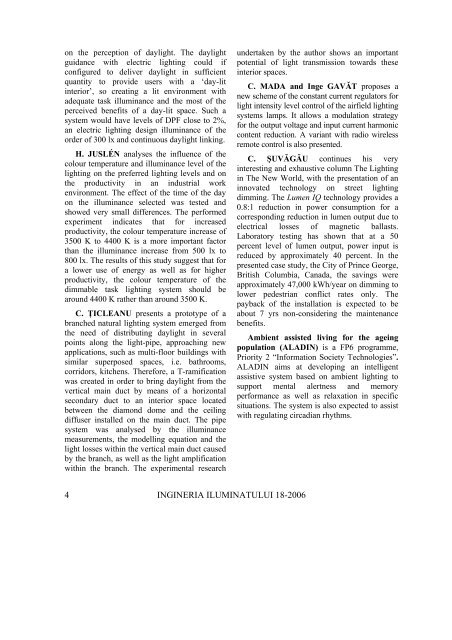This issue is sponsored by the Philips Romania, Lighting Division
This issue is sponsored by the Philips Romania, Lighting Division
This issue is sponsored by the Philips Romania, Lighting Division
You also want an ePaper? Increase the reach of your titles
YUMPU automatically turns print PDFs into web optimized ePapers that Google loves.
on <strong>the</strong> perception of daylight. The daylight<br />
guidance with electric lighting could if<br />
configured to deliver daylight in sufficient<br />
quantity to provide users with a ‘day-lit<br />
interior’, so creating a lit environment with<br />
adequate task illuminance and <strong>the</strong> most of <strong>the</strong><br />
perceived benefits of a day-lit space. Such a<br />
system would have levels of DPF close to 2%,<br />
an electric lighting design illuminance of <strong>the</strong><br />
order of 300 lx and continuous daylight linking.<br />
H. JUSLÉN analyses <strong>the</strong> influence of <strong>the</strong><br />
colour temperature and illuminance level of <strong>the</strong><br />
lighting on <strong>the</strong> preferred lighting levels and on<br />
<strong>the</strong> productivity in an industrial work<br />
environment. The effect of <strong>the</strong> time of <strong>the</strong> day<br />
on <strong>the</strong> illuminance selected was tested and<br />
showed very small differences. The performed<br />
experiment indicates that for increased<br />
productivity, <strong>the</strong> colour temperature increase of<br />
3500 K to 4400 K <strong>is</strong> a more important factor<br />
than <strong>the</strong> illuminance increase from 500 lx to<br />
800 lx. The results of th<strong>is</strong> study suggest that for<br />
a lower use of energy as well as for higher<br />
productivity, <strong>the</strong> colour temperature of <strong>the</strong><br />
dimmable task lighting system should be<br />
around 4400 K ra<strong>the</strong>r than around 3500 K.<br />
C. ŢICLEANU presents a prototype of a<br />
branched natural lighting system emerged from<br />
<strong>the</strong> need of d<strong>is</strong>tributing daylight in several<br />
points along <strong>the</strong> light-pipe, approaching new<br />
applications, such as multi-floor buildings with<br />
similar superposed spaces, i.e. bathrooms,<br />
corridors, kitchens. Therefore, a T-ramification<br />
was created in order to bring daylight from <strong>the</strong><br />
vertical main duct <strong>by</strong> means of a horizontal<br />
secondary duct to an interior space located<br />
between <strong>the</strong> diamond dome and <strong>the</strong> ceiling<br />
diffuser installed on <strong>the</strong> main duct. The pipe<br />
system was analysed <strong>by</strong> <strong>the</strong> illuminance<br />
measurements, <strong>the</strong> modelling equation and <strong>the</strong><br />
light losses within <strong>the</strong> vertical main duct caused<br />
<strong>by</strong> <strong>the</strong> branch, as well as <strong>the</strong> light amplification<br />
within <strong>the</strong> branch. The experimental research<br />
4<br />
INGINERIA ILUMINATULUI 18-2006<br />
undertaken <strong>by</strong> <strong>the</strong> author shows an important<br />
potential of light transm<strong>is</strong>sion towards <strong>the</strong>se<br />
interior spaces.<br />
C. MADA and Inge GAVĂT proposes a<br />
new scheme of <strong>the</strong> constant current regulators for<br />
light intensity level control of <strong>the</strong> airfield lighting<br />
systems lamps. It allows a modulation strategy<br />
for <strong>the</strong> output voltage and input current harmonic<br />
content reduction. A variant with radio wireless<br />
remote control <strong>is</strong> also presented.<br />
C. ŞUVĂGĂU continues h<strong>is</strong> very<br />
interesting and exhaustive column The <strong>Lighting</strong><br />
in The New World, with <strong>the</strong> presentation of an<br />
innovated technology on street lighting<br />
dimming. The Lumen IQ technology provides a<br />
0.8:1 reduction in power consumption for a<br />
corresponding reduction in lumen output due to<br />
electrical losses of magnetic ballasts.<br />
Laboratory testing has shown that at a 50<br />
percent level of lumen output, power input <strong>is</strong><br />
reduced <strong>by</strong> approximately 40 percent. In <strong>the</strong><br />
presented case study, <strong>the</strong> City of Prince George,<br />
Brit<strong>is</strong>h Columbia, Canada, <strong>the</strong> savings were<br />
approximately 47,000 kWh/year on dimming to<br />
lower pedestrian conflict rates only. The<br />
payback of <strong>the</strong> installation <strong>is</strong> expected to be<br />
about 7 yrs non-considering <strong>the</strong> maintenance<br />
benefits.<br />
Ambient ass<strong>is</strong>ted living for <strong>the</strong> ageing<br />
population (ALADIN) <strong>is</strong> a FP6 programme,<br />
Priority 2 “Information Society Technologies”.<br />
ALADIN aims at developing an intelligent<br />
ass<strong>is</strong>tive system based on ambient lighting to<br />
support mental alertness and memory<br />
performance as well as relaxation in specific<br />
situations. The system <strong>is</strong> also expected to ass<strong>is</strong>t<br />
with regulating circadian rhythms.
















